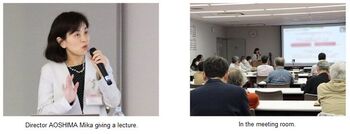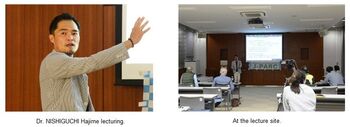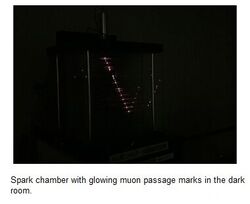J-PARC News July 2023 (Issue #218)
■Fire in the Power Supply Building of J-PARC Hadron Experimental Facility
Due to a fire that broke out in the Power Supply Building of Hadron Experimental Facility at around 0:51 a.m. on Thursday, June 22, the J-PARC accelerator operation before the summer maintenance period has been cancelled.
Details of this incident, countermeasures, and schedule will be announced later. We deeply apologize for the concerns caused to you by the incident.
Takashi Kobayashi, Director of J-PARC Center
■Dr. Asami Sano of Neutron Science Section Received “Nishida Prize for Promotion of Geo- and Planetary Science “
Dr. Asami Sano of the Neutron Science Section received the “Nishida Prize for Promotion of Geo- and Planetary Science” from Japan Geoscience Union for research on hydrogen in the Earth’s materials at high pressure and temperature based on synchrotron X-ray and neutron beams. She has contributed unique research on elucidating the stability of hydrous minerals and the behavior of hydrogen in the crystal structure at high pressures using X-ray and neutron diffraction techniques. She has also been involved in developing the large-volume multi-anvil press at the high-pressure neutron diffractometer PLANET in MLF to realize neutron scattering experiments under high-pressures and high-temperatures.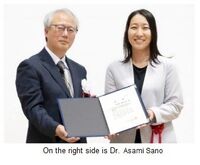
■J-PARC Safety Day (May 23)
"J-PARC Safety Day" is held every year around May 23, the date of the incident, to build a safe J-PARC without fading away the lessons learned from the radioactive material leak incident in 2013. With a total of 358 attendees, this year's event was held in a hybrid format. A safety information exchange session was held in the morning, where various efforts on radiation safety at each facility were presented. In the afternoon, the workshop for fostering a safety culture was held. After the Director's address, the Safety Contribution Award for three staff members and the Best Practices Award for two teams were presented. Next, AOSHIMA Mika, Director of the Laboratory for Developing Team Competence, gave a lecture entitled "Psychological Safety for a Foundation for Teamwork". Psychological safety is a state in which everyone has the belief that his or her team is safe, even in the face of interpersonal risk behavior. The psychological safety foundation of a team promotes learning from mistakes, making decisions with correct information, and preventing misconduct and fraud. Tips for creating such a team climate were suggested, possessing respect for self and others, independence and fairness, and transparency. Finally, a documentary film and a panel discussion were held under the title "Ten Years After the Radioactive Material Leak Incident."
■9th Symposium on Safety in Accelerator Facilities (June 9th)
The 9th Symposium on Safety in Accelerator Facilities was held by J-PARC Center at Tokai-mura industry and an information plaza (iVil). It was the first time in about three and a half years that the event was held in a face-to-face format, and 105 people attended. Act on the Regulation of Radioisotopes, etc. will be revised on October 1 this year, and the inspection and calibration of radiation measuring instruments will become a legal compliance item. Information was exchanged on how each facility should respond to the mandatory requirement to ensure the reliability of radiation measurements. In recent years, many fires caused by electrical equipment have occurred at nuclear facilities in the prefecture, and the importance of preventing electrical fires and ensuring electrical safety at large accelerator facilities that consume large amounts of electricity has been reaffirmed. Therefore, information on electrical fire prevention and electrical safety initiatives was also exchanged. In June 2024, the International Technical Safety Forum 2024 will be held at the RIKEN Wako Campus to exchange information with people involved in the safety management of accelerator facilities around the world.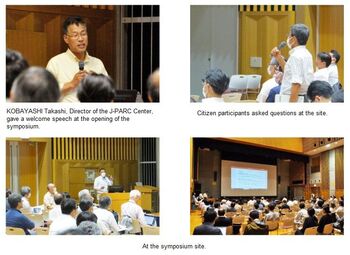
■J-PARC Hello Science "For Production of 85 Trillion Muons per Minute" on May 26th
Dr. NISHIGUCHI Hajime from the Hadron Section gave a talk at the "Hello Science" in May. By introducing the COMET (COherent Muon to Electron Transition) experiment, which aims to discover the "violation" of existing symmetries in particle physics and to construct new physics, he conveyed the difficulty and fun of dealing with huge numbers of muons.
The new physics theory, which attempts to go beyond the Standard Model of elementary particles, predicts that a muon will decay to an electron about once every ten quadrillions of normal muon decay (a muon decays to an electron, antielectron-neutrino, and muon-neutrino in about 200 μs), which means violation of the symmetry of the number of generations. To find and reproduce this extremely rare phenomenon would require at least 1,000 times the number of attempts predicted or 10 thousand quadrillion muons. The COMET experiment at J-PARC aims to study symmetry violation in the generations of elementary particles by producing large numbers of muons, about 85 trillion per minute.
Clean beams and light tracking detectors are needed to handle the huge number of muons. Data is not always collected, and if protons leak from a bunch forcefully condensed by the electric field, called a "bucket," when the necessary data is collected, they cannot be distinguished from the correct signal. By adjusting the parameters of accelerator operation, J-PARC has achieved the world's cleanest beam, with less than one proton leaking when a bucket is filled to the 10th power of 10 protons. To reduce the effects of Coulomb multiple scattering, a straw chamber detector is also successfully operated by filling a thin film straw with active gas in a vacuum.
At the Hadron Experimental Facility, the proton beam transport system for the COMET experiment has been completed, and the detector is in the final stages of construction. The launch of the COMET experiment will be in the year 2025.
■Muography Project to See through Burial Mounds Held (June 18)
In April of this year, the Tokai-Village Board of Education and the J-PARC Center jointly started a project to nondestructively see through the interior of an ancient burial mound in Tokai-Village using muons, a type of cosmic ray. Project activities are held once a month. A hands-on class on observing cosmic rays was held in April, and a lecture on the ancient burial mounds of Tokai Village was held in May.
This month's lecture, the third in the series, was given by J-PARC Director Takashi Kobayashi and Deputy Director Koichiro Shimomura of the Materials and Life Science Division on the topic of "What Descends from Space" and was attended by 43 people, including elementary school students. Muons cannot be seen or felt, even though they constantly fly out of space. However, using a spark chamber device, the muon's path appears as a streak of light. The presence of muons in the visualization surprised and excited the participants. This project will be continued in the future with a variety of activities.
For more information, please visit the Tokai Village website.
■"Guest Lectures by J-PARC" at Oose Elementary School (June 1st)
Dr. Aine Kobayashi is a researcher working on the main ring of the J-PARC. Currently, the upgrades for increasing the beam power are ongoing. She is studying a stable supply of high intensity proton beams. She has been interested in space and science since childhood. This time, she was asked if she would give a lecture to third graders at the elementary school, and decided to accept the offer, hoping that it would help broaden the children's interest.
This guest lecture was held at Oose Elementary School, which applied for the program organized by the Hitachi Civic Center for elementary schools in Hitachi City.
On June 1st, Dr. Kobayashi’s class began in the presence of 33 children, parents, and other school staff. She began by locating the Oose Elementary School on a map and then led them in expanding their perspective of the Earth, the solar system, the galaxy, and the universe. Responding to the children’s comments and expressions, Dr. Kobayashi calmly explained the mechanism of the birth of the universe and elementary particles such as neutrinos. The children asked one question after another. She also described dark energy and dark matter, and the matter-dominated universe. Then she introduced the features and role of the J-PARC in unraveling the mysteries of the universe.
In the next class, the children made "kaleidoscopes of light". The classroom was filled with cheers when they pointed their kaleidoscopes at the light source, creating beautiful light patterns.
We are active in outreach as well as research; please see below for information on how to request a tour of the J-PARC and a speaker to visit your institution.
About the J-PARC facility tour; https://j-parc.jp/c/en/visit/index.html
About "Guest Lectures by J-PARC" or "Online Lecture by J-PARC";https://j-parc.jp/c/information/2023/05/09001153.html (only in Japanese)

